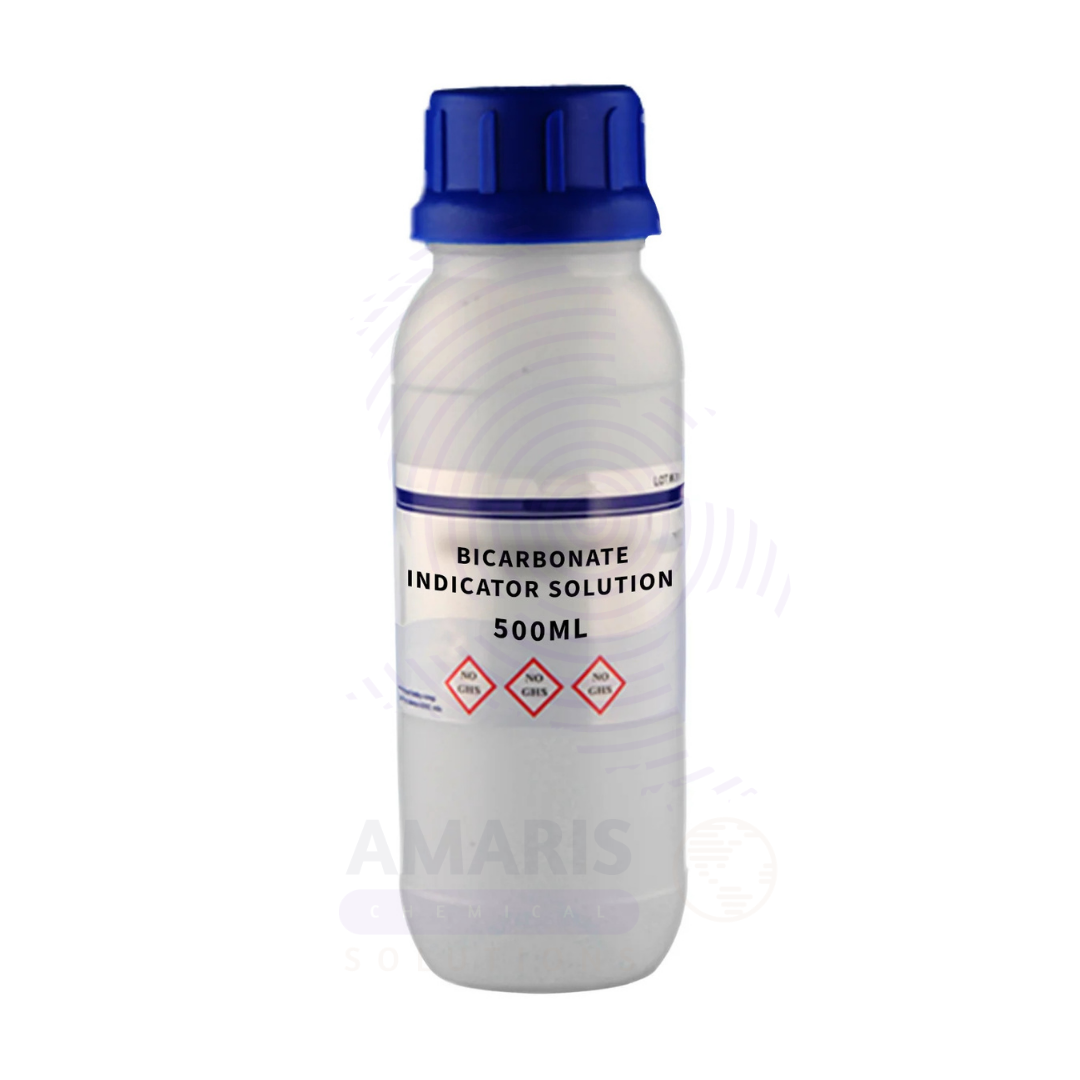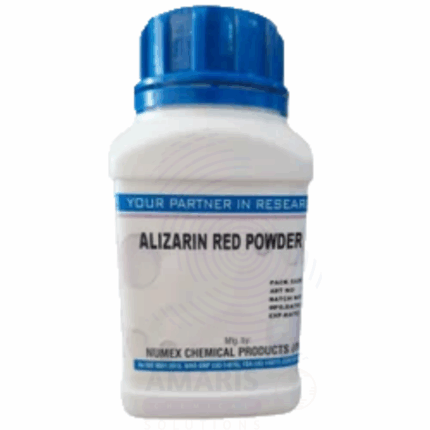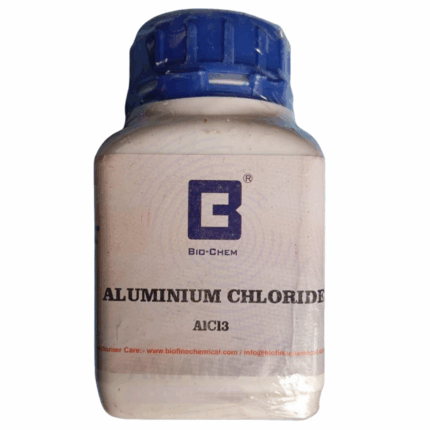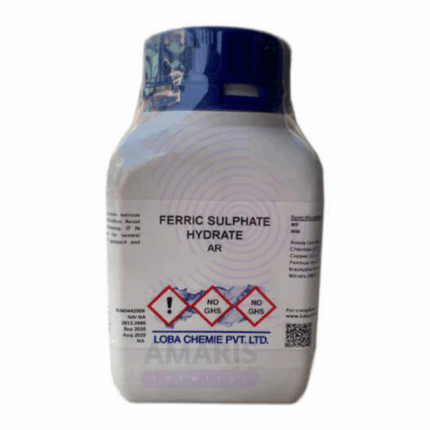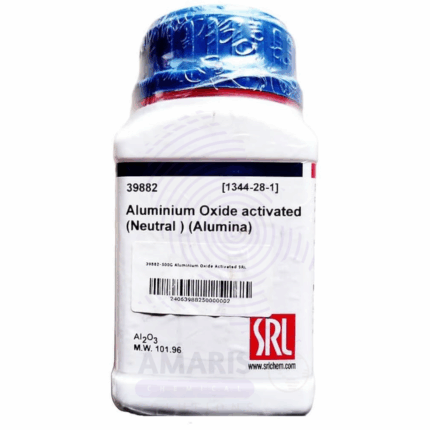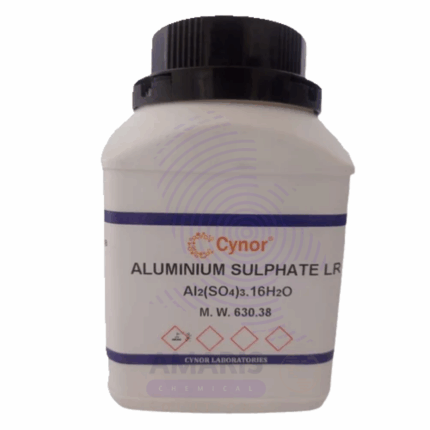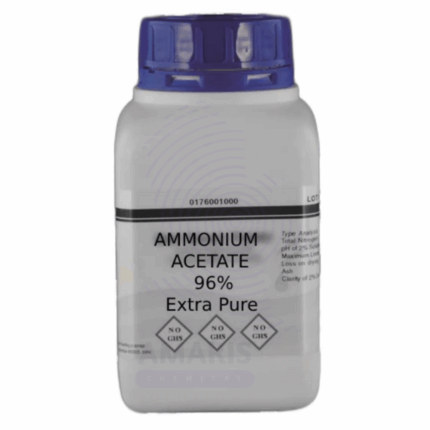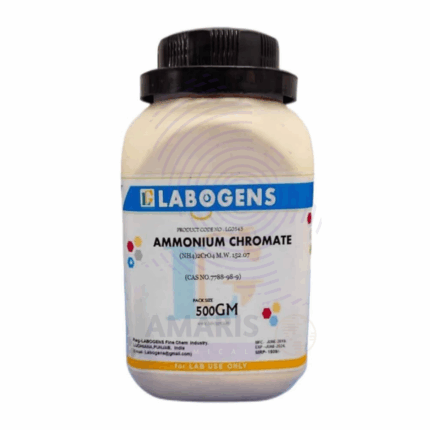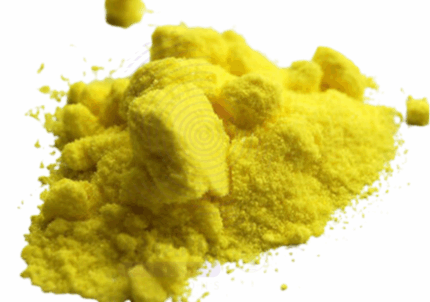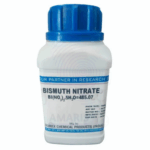
Bicarbonate Indicator Extra Pure
$ 17.00 Original price was: $ 17.00.$ 16.45Current price is: $ 16.45.
Bicarbonate Indicator Extra Pure is a high-purity, specially formulated solution used in laboratory settings to detect and monitor changes in bicarbonate ion concentration, particularly in biological and environmental experiments. It typically contains a pH-sensitive dye that changes color in response to shifts in carbon dioxide or bicarbonate levels, making it valuable in studies of respiration, photosynthesis, and water quality. This indicator is often employed in teaching labs to visually demonstrate gas exchange or acid-base balance. The extra pure grade ensures consistent performance, color clarity, and minimal background interference in precise analytical work. It should be stored in a cool, dark place in a tightly closed container to maintain its sensitivity and stability.
Bicarbonate Indicator Extra Pure
Primary Uses
- Indicator for CO₂ Concentration in Aqueous Systems
- Used to visually monitor changes in dissolved carbon dioxide, particularly in photosynthesis and respiration experiments.
- Teaching Photosynthesis in Plant Physiology Labs
- Demonstrates the uptake of CO₂ by aquatic plants (e.g., Elodea) through color change as bicarbonate ions are consumed during carbon fixation.
- Buffer System Visualization
- Illustrates pH shifts in bicarbonate–carbonic acid equilibrium in teaching acid–base chemistry and buffering action.
- Qualitative CO₂ Detection
- Acts as a colorimetric detector in lab setups for identifying CO₂ evolution during fermentation or respiration studies.
Secondary Uses
- Classroom Demonstrations
- Ideal for visual experiments showing acid–base reactions, gas exchange, or carbonate buffering, often in educational institutions.
- Color Indicator in Field CO₂ Measurement Kits
- May be used in portable lab kits or environmental sampling tools for quick CO₂ assessment in water or soil solutions.
- Calibration of pH-Responsive Systems
- Useful for calibrating pH sensors or colorimetric assays involving weak acid–base systems.
| PACK SIZE |
500ml |
|---|
1. Basic Identification Attributes
- Chemical Name: Bicarbonate Indicator (Mixture – typically includes bromocresol green or phenol red in a suitable buffer)
- Common Name: Bicarbonate Indicator
- CAS Number: Mixture (individual components like Bromocresol Green: 76-60-8, Phenol Red: 143-74-8)
- HS Code: 3822.00.00 (Diagnostic or laboratory reagents)
- Molecular Formula: Not applicable (Mixture)
- Synonyms:
- Bicarbonate pH indicator
- CO₂ indicator solution
- Alkalinity indicator solution
- Carbon dioxide detection reagent
2. Physical & Chemical Properties
- Physical State: Liquid (aqueous solution)
- Color & Odor: Green to yellow color shift (if Bromocresol Green is used), odorless
- Boiling Point: ~100 °C (aqueous base)
- Melting Point: Not applicable
- Density: ~1.0 g/cm³
- Solubility:
- Water: Fully miscible
- Organic Solvents: Not typically used in organic media
- pH Range (color change):
- Bromocresol Green: 3.8 (yellow) – 5.4 (blue)
- Phenol Red: 6.4 (yellow) – 8.2 (red)
- Vapor Pressure: Like water (~24 mmHg at 25 °C)
- Flash Point: Not flammable
- Autoignition Temperature: Not applicable
- Viscosity: Similar to water
3. Safety & Hazard Attributes
- GHS Classification:
- Not hazardous under normal laboratory use
- NFPA Ratings:
- Health: 1
- Flammability: 0
- Reactivity: 0
- Exposure Limits:
- No OSHA/ACGIH limits established for diluted indicators
- Reactivity:
- Stable under normal conditions
- Avoid strong acids or bases which may affect indicator accuracy
4. Storage & Handling Attributes
- Storage Conditions:
- Store at room temperature, away from light
- Avoid contamination and extreme pH exposure
- Incompatible Materials:
- Strong acids and alkalis
- Oxidizing agents
- Container Type:
- Amber glass or HDPE bottle
- Shelf Life:
- 1–2 years if stored properly
- Special Handling Requirements:
- Use gloves, avoid skin contact
- Use in well-ventilated area or under fume hood when working with concentrated acids
5. Regulatory & Compliance Attributes
- Regulatory Status:
- Not regulated as hazardous under GHS, OSHA, or REACH
- Hazard Symbols (GHS pictograms):
- None typically required
- Transportation Restrictions:
- Not classified as hazardous for transport
- Waste Disposal Method:
- Dispose as non-hazardous lab waste in accordance with institutional/local guidelines
6. Environmental & Health Impact
- Ecotoxicity:
- Low at laboratory-use concentrations
- Persistence in Environment:
- Readily biodegradable (due to organic dye components)
- Carcinogenicity/Mutagenicity:
- No known carcinogenic or mutagenic effects at lab concentrations
- Biodegradability:
- Components are generally biodegradable
SAFETY PRECAUTIONS
- Personal Protective Equipment (PPE):
- Wear lab coat, protective gloves (nitrile recommended), and safety goggles.
- Use in a well-ventilated space or under a fume hood if in liquid form or aerosolized.
- Handling:
- Handle with care to avoid spillage or aerosol formation.
- Avoid direct contact with skin or eyes.
- Do not breathe in dust, vapor, or mist.
- Storage:
- Keep container tightly sealed.
- Store in a cool, dry place, protected from light and incompatible materials (strong oxidizers or acids).
- Hygiene Measures:
- Wash hands thoroughly after handling.
- Do not eat, drink, or smoke during use.
FIRST AID MEASURES
- Inhalation:
- Move the affected person to fresh air.
- Seek medical attention if discomfort or symptoms persist.
- Skin Contact:
- Rinse skin with plenty of water and soap.
- Remove contaminated clothing.
- Eye Contact:
- Rinse cautiously with water for at least 15 minutes.
- Seek medical assistance if irritation persists.
- Ingestion:
- Rinse mouth.
- Do not induce vomiting.
- Seek immediate medical advice.
FIRE FIGHTING MEASURES
- Extinguishing Media:
- Use carbon dioxide, dry chemical powder, foam, or water spray.
- Fire Hazards:
- May emit toxic or irritating fumes if heated or decomposed (e.g., carbon oxides depending on the composition).
- Not highly flammable but may support combustion of other substances.
- Protective Equipment:
- Firefighters should wear self-contained breathing apparatus (SCBA) and appropriate fire gear.


 Preservatives(food)
Preservatives(food) Flavor Enhancers
Flavor Enhancers Acidulants
Acidulants Sweeteners
Sweeteners Antioxidants
Antioxidants Colorants(food)
Colorants(food) Nutraceutical Ingredients (food)
Nutraceutical Ingredients (food) Nutrient Supplements
Nutrient Supplements Emulsifiers
Emulsifiers
 Collectors
Collectors Dust Suppressants
Dust Suppressants Explosives and Blasting Agents
Explosives and Blasting Agents Flocculants and Coagulants
Flocculants and Coagulants Frothers
Frothers Leaching Agents
Leaching Agents pH Modifiers
pH Modifiers Precious Metal Extraction Agents
Precious Metal Extraction Agents
 Antioxidants(plastic)
Antioxidants(plastic) Colorants (Pigments, Dyes)
Colorants (Pigments, Dyes) Fillers and Reinforcements
Fillers and Reinforcements Flame Retardants
Flame Retardants Monomers
Monomers Plasticizers
Plasticizers Polymerization Initiators
Polymerization Initiators Stabilizers (UV, Heat)
Stabilizers (UV, Heat)
 Antifoaming Agents
Antifoaming Agents Chelating Agents
Chelating Agents Coagulants and Flocculants
Coagulants and Flocculants Corrosion Inhibitors
Corrosion Inhibitors Disinfectants and Biocides
Disinfectants and Biocides Oxidizing Agents
Oxidizing Agents pH Adjusters
pH Adjusters Scale Inhibitors( water)
Scale Inhibitors( water)
 Antioxidants(cosmetic)
Antioxidants(cosmetic) Emollients
Emollients Fragrances and Essential Oils
Fragrances and Essential Oils Humectants
Humectants Preservatives
Preservatives Surfactants(cosmetic)
Surfactants(cosmetic) Thickeners
Thickeners UV Filters
UV Filters
 Fertilizers
Fertilizers Soil Conditioners
Soil Conditioners Plant Growth Regulators
Plant Growth Regulators Animal Feed Additives
Animal Feed Additives Biostimulants
Biostimulants Pesticides (Herbicides, Insecticides, Fungicides)
Pesticides (Herbicides, Insecticides, Fungicides)
 Active Pharmaceutical Ingredients (APIs)
Active Pharmaceutical Ingredients (APIs) Excipients
Excipients Solvents(pharmaceutical)
Solvents(pharmaceutical) Antibiotics
Antibiotics Antiseptics and Disinfectants
Antiseptics and Disinfectants Vaccine Adjuvants
Vaccine Adjuvants Nutraceutical Ingredients (pharmaceutical)
Nutraceutical Ingredients (pharmaceutical) Analgesics & Antipyretics
Analgesics & Antipyretics
 Analytical Reagents
Analytical Reagents Solvents(lab)
Solvents(lab) Chromatography Chemicals
Chromatography Chemicals Spectroscopy Reagents
Spectroscopy Reagents microbiology-and-cell-culture-reagents
microbiology-and-cell-culture-reagents Molecular Biology Reagents
Molecular Biology Reagents Biochemical Reagents
Biochemical Reagents Inorganic and Organic Standards
Inorganic and Organic Standards Laboratory Safety Chemicals
Laboratory Safety Chemicals Specialty Laboratory Chemicals(Special Laboratory Equipment)
Specialty Laboratory Chemicals(Special Laboratory Equipment)
 Demulsifiers
Demulsifiers Hydraulic Fracturing Fluids
Hydraulic Fracturing Fluids Scale Inhibitors(oil)
Scale Inhibitors(oil) Surfactants(oil)
Surfactants(oil) Drilling Fluids
Drilling Fluids
 Dyes and Pigments
Dyes and Pigments Bleaching Agents
Bleaching Agents Softening Agents
Softening Agents Finishing Agents
Finishing Agents Antistatic Agents
Antistatic Agents
 Admixtures
Admixtures Waterproofing Agents
Waterproofing Agents Sealants and Adhesives
Sealants and Adhesives Curing Compounds
Curing Compounds Concrete Repair Chemicals
Concrete Repair Chemicals Anti-Corrosion Coatings
Anti-Corrosion Coatings
 Surfactants(cleaning)
Surfactants(cleaning) Builders
Builders Enzymes
Enzymes Solvents (Cleaning)
Solvents (Cleaning) Fragrances
Fragrances
 Electronic Chemicals
Electronic Chemicals Catalysts
Catalysts Lubricants
Lubricants Photographic Chemicals
Photographic Chemicals Refrigerants
Refrigerants Automotive chemicals
Automotive chemicals Pyrotechnic Chemicals
Pyrotechnic Chemicals
 Biodegradable Surfactants
Biodegradable Surfactants Bio-based Solvents
Bio-based Solvents Renewable Polymers
Renewable Polymers Carbon Capture Chemicals
Carbon Capture Chemicals Wastewater Treatment Chemicals
Wastewater Treatment Chemicals
 Pigments
Pigments Solvents(paint)
Solvents(paint) Specialty Coatings
Specialty Coatings Binders/Resins
Binders/Resins Additives
Additives Driers
Driers Anti-Corrosion Agents
Anti-Corrosion Agents Functional Coatings
Functional Coatings Application-Specific Coatings
Application-Specific Coatings
 Fresh Herbs
Fresh Herbs Ground Spices
Ground Spices Whole Spices
Whole Spices Spice Blends
Spice Blends Dried Herbs
Dried Herbs
 Leavening Agents
Leavening Agents Dough Conditioners
Dough Conditioners Flour Treatments
Flour Treatments Fat Replacers
Fat Replacers Decoratives
Decoratives Preservatives(baking)
Preservatives(baking)
 Plasticizers & Softeners
Plasticizers & Softeners Reinforcing Agents
Reinforcing Agents Adhesion Promoters
Adhesion Promoters Vulcanizing Agents
Vulcanizing Agents Antidegradants
Antidegradants Blowing Agents
Blowing Agents Fillers & Extenders
Fillers & Extenders Accelerators & Retarders
Accelerators & Retarders